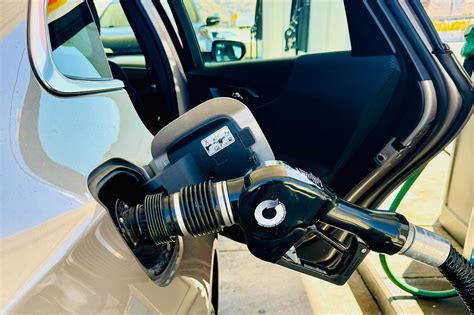
Capless fueling systems are becoming increasingly common in new vehicles, prompting many drivers to wonder about the fate of the traditional gas cap. Automakers are adopting this design for its convenience, efficiency, and enhanced fuel-sealing capabilities.
The disappearing gas cap isn’t merely a design fad but a deliberate engineering choice driven by several factors. Automakers are embracing capless fuel systems, also known as Easy Fuel systems, for their ease of use and potential to reduce emissions. These systems eliminate the need to unscrew and replace a gas cap, which can be inconvenient, especially in inclement weather. More importantly, they provide a tighter seal than traditional caps, helping to prevent fuel vapors from escaping into the atmosphere. “A capless system’s spring-loaded flapper door creates a tighter seal than a screw-on cap, and it can’t be left at the filling station,” according to Yahoo Autos. This addresses both user convenience and environmental concerns, making it a win-win for both drivers and manufacturers.
Benefits of Capless Fueling Systems
Capless fueling offers several advantages that appeal to both automakers and consumers.
-
Convenience: The most obvious benefit is the elimination of the need to remove and replace a gas cap. This simplifies the fueling process and saves time, especially in bad weather. No more fumbling with a dirty gas cap or worrying about where to put it while filling up.
-
Improved Seal: Capless systems create a tighter seal than traditional caps, preventing fuel vapors from escaping into the atmosphere. This reduces emissions and helps automakers meet increasingly stringent environmental regulations. The spring-loaded flapper door ensures a secure closure, minimizing evaporative losses.
-
Reduced Risk of Fuel Spillage: The design of capless systems minimizes the risk of fuel spillage during refueling. The nozzle fits snugly into the fuel filler neck, preventing drips and splashes.
-
Prevention of Lost Caps: One of the most common annoyances for drivers is losing or forgetting the gas cap at the filling station. Capless systems eliminate this problem altogether, as there is no cap to lose.
-
Enhanced Security: Some capless systems incorporate security features that prevent fuel theft. The design makes it difficult to siphon fuel from the tank, providing an added layer of protection.
How Capless Fueling Systems Work
Capless fueling systems use a spring-loaded flapper door that seals the fuel filler neck when the fuel nozzle is removed. When refueling, the nozzle pushes the flapper door open, allowing fuel to flow into the tank. Once the nozzle is removed, the flapper door automatically closes, creating a tight seal.
The design incorporates several key components:
-
Fuel Filler Neck: This is the opening where the fuel nozzle is inserted. It is typically made of metal or plastic and is designed to accommodate standard fuel nozzles.
-
Flapper Door: The flapper door is a spring-loaded valve that seals the fuel filler neck when the nozzle is not inserted. It is typically made of a durable plastic or metal material that is resistant to fuel and other contaminants.
-
Spring Mechanism: The spring mechanism provides the force needed to keep the flapper door closed. It is designed to be reliable and long-lasting, ensuring a consistent seal over time.
-
Sealing Gasket: A sealing gasket is used to create a tight seal between the flapper door and the fuel filler neck. This gasket is typically made of a rubber or synthetic material that is resistant to fuel and other contaminants.
Why Automakers Are Adopting Capless Fueling
The shift towards capless fueling is driven by a combination of factors, including:
-
Environmental Regulations: Automakers are under increasing pressure to reduce emissions and improve fuel economy. Capless fueling systems help them meet these requirements by preventing fuel vapors from escaping into the atmosphere.
-
Consumer Demand: Drivers are increasingly demanding convenience and ease of use. Capless fueling systems offer a simple and hassle-free refueling experience.
-
Cost Savings: While the initial cost of capless systems may be slightly higher than traditional caps, they can save money in the long run by reducing fuel evaporation and the need to replace lost or damaged caps.
-
Marketing Advantage: Capless fueling can be a selling point for new vehicles. Automakers can promote it as a modern and innovative feature that enhances the driving experience.
Potential Drawbacks of Capless Fueling Systems
While capless fueling systems offer many advantages, there are also some potential drawbacks to consider:
-
Contamination: One concern is the potential for dirt and debris to enter the fuel tank when refueling in dusty or dirty environments. While the flapper door is designed to prevent this, it is still possible for contaminants to accumulate around the opening.
-
Fuel Additives: Adding fuel additives to the fuel tank can be more difficult with capless systems. Some additives may require a special funnel or adapter to be poured into the tank without spilling.
-
Repair Costs: If a capless system malfunctions, the repair costs may be higher than for a traditional gas cap. The system is more complex and may require specialized tools and expertise to fix.
-
Compatibility Issues: In rare cases, some fuel nozzles may not be compatible with capless systems. This can make it difficult to refuel at certain gas stations.
Addressing Potential Drawbacks
Automakers have taken steps to address the potential drawbacks of capless fueling systems.
-
Protective Mechanisms: Many systems incorporate protective mechanisms to prevent dirt and debris from entering the fuel tank. This may include a secondary seal or a filter to trap contaminants.
-
Funnel Adapters: Some automakers provide a funnel adapter that can be used to add fuel additives to the tank. This adapter ensures that the additive is poured in cleanly and without spilling.
-
Durability Testing: Capless systems undergo rigorous durability testing to ensure that they can withstand the rigors of daily use. This testing includes exposure to extreme temperatures, vibration, and other environmental factors.
-
Standardization Efforts: Efforts are underway to standardize the design of capless systems to ensure compatibility with all fuel nozzles. This will help to eliminate the risk of refueling problems at gas stations.
The Future of Fueling
Capless fueling is likely to become even more prevalent in the future as automakers continue to seek ways to improve fuel efficiency and reduce emissions. As electric vehicles gain popularity, fueling systems may evolve even further, with new technologies such as wireless charging and automated refueling systems becoming more common.
The evolution of fueling technology is driven by several factors, including:
-
Sustainability: The need to reduce greenhouse gas emissions and improve air quality is driving innovation in fueling technology. Electric vehicles and alternative fuels are becoming increasingly popular as a result.
-
Convenience: Drivers are demanding more convenient and hassle-free fueling options. Capless fueling, wireless charging, and automated refueling systems are all designed to meet this demand.
-
Efficiency: Automakers are constantly seeking ways to improve fuel efficiency and reduce energy consumption. Advanced fueling technologies can help to achieve these goals.
-
Safety: Safety is a top priority in the automotive industry. New fueling technologies are designed to be safer and more reliable than traditional systems.
Alternative Fueling Technologies
In addition to capless fueling, several other alternative fueling technologies are being developed and implemented.
-
Electric Vehicles (EVs): EVs are powered by electricity and produce zero emissions. They can be charged at home or at public charging stations.
-
Plug-in Hybrid Electric Vehicles (PHEVs): PHEVs combine a gasoline engine with an electric motor and battery. They can be driven on electricity for a certain range and then switch to gasoline when the battery is depleted.
-
Hydrogen Fuel Cell Vehicles (FCVs): FCVs use hydrogen fuel to generate electricity, which powers an electric motor. They produce only water vapor as emissions.
-
Compressed Natural Gas (CNG) Vehicles: CNG vehicles run on compressed natural gas, a cleaner-burning fuel than gasoline.
-
Liquefied Petroleum Gas (LPG) Vehicles: LPG vehicles run on liquefied petroleum gas, another cleaner-burning fuel than gasoline.
The Environmental Impact of Fueling Systems
The environmental impact of fueling systems is a major concern for automakers and consumers alike. Traditional gasoline-powered vehicles are a major source of greenhouse gas emissions and air pollution. Alternative fueling technologies offer the potential to significantly reduce these impacts.
-
Greenhouse Gas Emissions: Greenhouse gases, such as carbon dioxide, trap heat in the atmosphere and contribute to climate change. Gasoline-powered vehicles emit significant amounts of greenhouse gases.
-
Air Pollution: Gasoline-powered vehicles also emit air pollutants, such as smog and particulate matter, which can harm human health and the environment.
-
Fuel Spillage: Fuel spillage during refueling can contaminate soil and water resources. Capless fueling systems help to minimize the risk of fuel spillage.
-
Evaporative Emissions: Evaporative emissions occur when fuel vapors escape from the fuel tank. Capless fueling systems help to prevent evaporative emissions.
Regulations and Standards
Fueling systems are subject to a variety of regulations and standards designed to protect the environment and ensure safety.
-
Environmental Protection Agency (EPA): The EPA sets emission standards for vehicles and regulates the sale of gasoline and other fuels.
-
National Highway Traffic Safety Administration (NHTSA): The NHTSA sets safety standards for vehicles, including fuel system integrity.
-
California Air Resources Board (CARB): CARB sets stricter emission standards than the EPA and is a leader in the development of clean vehicle technologies.
-
International Standards: International standards, such as those developed by the International Organization for Standardization (ISO), also apply to fueling systems.
Consumer Considerations
When choosing a vehicle with a capless fueling system, consumers should consider the following:
-
Ease of Use: Capless fueling systems are generally easy to use, but some designs may be more convenient than others.
-
Potential Drawbacks: Be aware of the potential drawbacks of capless systems, such as the risk of contamination and the difficulty of adding fuel additives.
-
Maintenance Requirements: Understand the maintenance requirements of the capless system and follow the manufacturer’s recommendations.
-
Warranty Coverage: Check the warranty coverage for the capless system and ensure that it is adequate.
-
Alternative Fueling Options: Consider alternative fueling options, such as electric vehicles or plug-in hybrid vehicles, which offer the potential to reduce emissions and save money on fuel costs.
Conclusion
The shift towards capless fueling systems represents a significant change in automotive design and technology. These systems offer several advantages over traditional gas caps, including convenience, improved sealing, and reduced emissions. While there are some potential drawbacks to consider, automakers are taking steps to address these issues. As environmental regulations become more stringent and consumer demand for convenience increases, capless fueling is likely to become even more prevalent in the future. Furthermore, the evolution of fueling technology extends beyond capless systems, encompassing electric vehicles, hydrogen fuel cells, and other alternative fueling options, all aimed at creating a more sustainable and efficient transportation future. The disappearance of the gas cap is not just a matter of convenience, but a reflection of the broader trends shaping the automotive industry.
Frequently Asked Questions (FAQ)
-
What is a capless fueling system?
A capless fueling system, also known as an Easy Fuel system, eliminates the need for a traditional gas cap. It uses a spring-loaded flapper door to seal the fuel filler neck when the fuel nozzle is removed. When refueling, the nozzle pushes the flapper door open, allowing fuel to flow into the tank. “A capless system’s spring-loaded flapper door creates a tighter seal than a screw-on cap, and it can’t be left at the filling station,” according to Yahoo Autos.
-
What are the benefits of capless fueling?
The benefits include increased convenience (no gas cap to remove or lose), a tighter fuel seal (reducing evaporative emissions), and a lower risk of fuel spillage.
-
Are there any drawbacks to capless fueling?
Potential drawbacks include the possibility of contamination from dirt and debris entering the fuel tank, difficulty adding fuel additives, and potentially higher repair costs if the system malfunctions.
-
How do I add fuel additives to a vehicle with a capless fueling system?
Some automakers provide a special funnel adapter that can be used to add fuel additives to the tank without spilling. Check your owner’s manual for specific instructions.
-
Are all fuel nozzles compatible with capless fueling systems?
While most fuel nozzles are compatible, there may be rare cases where a nozzle is not. Efforts are underway to standardize the design of capless systems to ensure compatibility.
Detailed Examination of Capless Fueling Components and Technologies
The engineering behind capless fueling is more sophisticated than a simple removal of a gas cap. It involves a series of carefully designed components working in harmony to ensure safe and efficient fuel delivery while minimizing environmental impact.
1. Fuel Filler Neck Design:
The fuel filler neck in a capless system is engineered to provide a secure and leak-proof connection with the fuel nozzle. The geometry of the neck is designed to accommodate standard fuel nozzle sizes while minimizing the risk of overfilling or fuel splash-back. Advanced materials, such as high-density polyethylene (HDPE) or composite materials, are used to resist corrosion from different fuel types, including gasoline, diesel, and ethanol blends.
2. Spring-Loaded Flapper Door Mechanism:
The heart of the capless system lies in the spring-loaded flapper door. This door is designed to create an airtight seal when the fuel nozzle is not inserted. The spring mechanism is calibrated to provide the optimal closing force, ensuring a tight seal without requiring excessive force to open it with the fuel nozzle. Materials used for the flapper door include fuel-resistant polymers and stainless steel, chosen for their durability and chemical resistance.
3. Sealing Technology:
The sealing performance of the flapper door is critical to preventing evaporative emissions. High-quality elastomers, such as Viton or fluorosilicone, are used to create a tight seal between the flapper door and the fuel filler neck. These materials are resistant to fuel degradation and maintain their elasticity over a wide range of temperatures. The design often incorporates multiple sealing surfaces to enhance leak prevention.
4. Contamination Prevention:
One of the significant concerns with capless systems is the potential for contaminants to enter the fuel tank. To mitigate this, advanced systems incorporate filtration and sealing mechanisms. Some designs include a secondary seal or a pre-filter to capture dirt and debris before they can enter the fuel tank. The fuel filler neck may also be designed with a tortuous path to prevent direct entry of contaminants.
5. Fuel Nozzle Compatibility:
Ensuring compatibility with different fuel nozzle types is a crucial design consideration. The fuel filler neck is designed to accommodate standard nozzle sizes and shapes. Some systems incorporate a mechanism to prevent the insertion of incorrect nozzle types, such as diesel nozzles into gasoline tanks, thereby preventing fuel contamination and potential engine damage.
6. Evaporative Emission Control:
Capless fueling systems play a vital role in reducing evaporative emissions, which contribute to smog and air pollution. The tight seal created by the flapper door and the sealing gasket minimizes the escape of fuel vapors into the atmosphere. These systems are designed to meet stringent evaporative emission standards set by regulatory agencies like the EPA and CARB.
7. Security Features:
Some capless systems incorporate security features to prevent fuel theft. The design makes it difficult to siphon fuel from the tank, providing an added layer of protection. These features may include anti-siphon devices and tamper-resistant mechanisms.
8. Diagnostic and Monitoring:
Advanced capless fueling systems may incorporate diagnostic and monitoring features to detect leaks or malfunctions. These systems can alert the driver to potential problems, allowing for timely repairs and preventing further environmental damage.
The Evolution of Automotive Fueling Systems: A Historical Perspective
The transition from traditional gas caps to capless fueling represents a significant step in the evolution of automotive fueling systems. Understanding this evolution provides context for the current trends and future directions.
Early Fueling Systems:
Early automobiles relied on simple fuel tanks with screw-on caps. These caps were often prone to leaks and did not provide adequate sealing against evaporative emissions. Fuel theft was also a common problem.
The Introduction of Locking Gas Caps:
To address fuel theft, locking gas caps were introduced. These caps provided a basic level of security but did not significantly improve sealing performance.
The Development of Advanced Sealing Technologies:
As environmental regulations became more stringent, automakers began to focus on improving the sealing performance of fuel systems. Advanced sealing technologies, such as rubber gaskets and vapor recovery systems, were developed to reduce evaporative emissions.
The Emergence of Capless Fueling:
Capless fueling systems emerged as a more convenient and effective way to prevent evaporative emissions and simplify the refueling process. These systems offer several advantages over traditional gas caps, including improved sealing, reduced risk of fuel spillage, and enhanced security.
The Future of Fueling Systems:
The future of fueling systems is likely to be shaped by several factors, including the increasing popularity of electric vehicles, the development of alternative fuels, and the need to further reduce emissions and improve fuel efficiency. New technologies, such as wireless charging and automated refueling systems, may become more common in the future.
The Role of Government Regulations in Fueling System Design
Government regulations play a critical role in shaping the design and performance of automotive fueling systems. These regulations are designed to protect the environment, ensure safety, and promote fuel efficiency.
Environmental Regulations:
Environmental regulations, such as those set by the EPA and CARB, limit the amount of evaporative emissions that vehicles can produce. These regulations have driven automakers to develop more effective sealing technologies, such as capless fueling systems.
Safety Regulations:
Safety regulations, such as those set by the NHTSA, require vehicles to meet certain safety standards, including fuel system integrity. These regulations ensure that fuel systems are designed to prevent leaks and fires in the event of an accident.
Fuel Efficiency Regulations:
Fuel efficiency regulations, such as those set by the Corporate Average Fuel Economy (CAFE) standards, require automakers to improve the fuel efficiency of their vehicles. These regulations have driven automakers to develop more efficient engines and fuel systems.
The Impact of Capless Fueling on the Automotive Industry
The adoption of capless fueling has had a significant impact on the automotive industry. It has driven innovation in fuel system design, improved fuel efficiency, and reduced emissions.
Design Innovation:
Capless fueling has spurred innovation in fuel system design, leading to the development of more efficient and reliable components. Automakers are constantly seeking ways to improve the performance and durability of capless systems.
Fuel Efficiency Improvements:
Capless fueling has contributed to fuel efficiency improvements by reducing evaporative emissions. This helps to improve the overall fuel economy of vehicles.
Emission Reductions:
Capless fueling has played a role in reducing emissions by preventing fuel vapors from escaping into the atmosphere. This helps to improve air quality and protect the environment.
Competitive Advantage:
Capless fueling can provide a competitive advantage for automakers. It is a modern and innovative feature that can attract customers and differentiate their vehicles from the competition.
Global Adoption of Capless Fueling Systems
The adoption of capless fueling systems is not limited to the United States. It is a global trend that is gaining momentum in other regions of the world.
Europe:
European automakers have also embraced capless fueling systems. These systems are becoming increasingly common in new vehicles sold in Europe.
Asia:
Asian automakers are also adopting capless fueling systems. These systems are particularly popular in Japan and South Korea.
Other Regions:
Capless fueling systems are also being adopted in other regions of the world, including South America, Africa, and Australia.
The Future of Capless Fueling Systems
The future of capless fueling systems is bright. These systems are likely to become even more prevalent in the future as automakers continue to seek ways to improve fuel efficiency, reduce emissions, and enhance the driving experience. Further advancements in materials science, engineering design, and sensor technology will continue to refine capless fueling systems, making them even more reliable, efficient, and environmentally friendly.
Areas for Future Development:
-
Smart Fueling Systems: Integration with vehicle telematics to provide real-time fuel efficiency monitoring and predictive maintenance.
-
Enhanced Security Measures: Development of more sophisticated anti-siphoning and fuel theft prevention technologies.
-
Universal Compatibility: Standardization of fuel filler neck designs to ensure compatibility with all fuel nozzle types globally.
-
Self-Cleaning Mechanisms: Incorporation of automated cleaning systems to prevent the accumulation of dirt and debris.
-
Advanced Materials: Utilization of nanotechnology and advanced composites to create lighter, stronger, and more durable components.
By addressing these areas for future development, capless fueling systems will continue to evolve, providing drivers with a more convenient, efficient, and environmentally responsible way to fuel their vehicles.
The broader Impact on Consumer Behavior and Expectations
The introduction of capless fueling has subtly shifted consumer expectations regarding vehicle convenience and ease of use. Drivers are increasingly accustomed to streamlined processes and technologies that simplify routine tasks. This expectation extends to the fueling process, where the elimination of the gas cap is perceived as a welcome improvement.
This trend reflects a broader shift in consumer behavior, driven by the increasing integration of technology into everyday life. Consumers are seeking products and services that offer seamless experiences, reduced effort, and enhanced efficiency. Automakers are responding to these demands by incorporating features that simplify the driving experience, such as capless fueling, automatic headlights, and keyless entry systems.
The adoption of capless fueling also reflects a growing awareness of environmental issues among consumers. Drivers are increasingly concerned about the environmental impact of their vehicles and are seeking ways to reduce their carbon footprint. Capless fueling systems, with their ability to minimize evaporative emissions, align with this trend and contribute to a more sustainable transportation future.
Furthermore, the widespread adoption of capless fueling has the potential to influence consumer perceptions of vehicle quality and innovation. Features that enhance convenience and reduce environmental impact are often viewed as indicators of a vehicle’s overall quality and technological sophistication. Automakers that embrace capless fueling and other innovative technologies may be better positioned to attract and retain customers.


![Browns QB Shakeup: [QB Name] Takes Lead at Minicamp!](https://jelajahtekno.com/wp-content/uploads/2025/06/unnamed-file-609-150x150.jpg)






